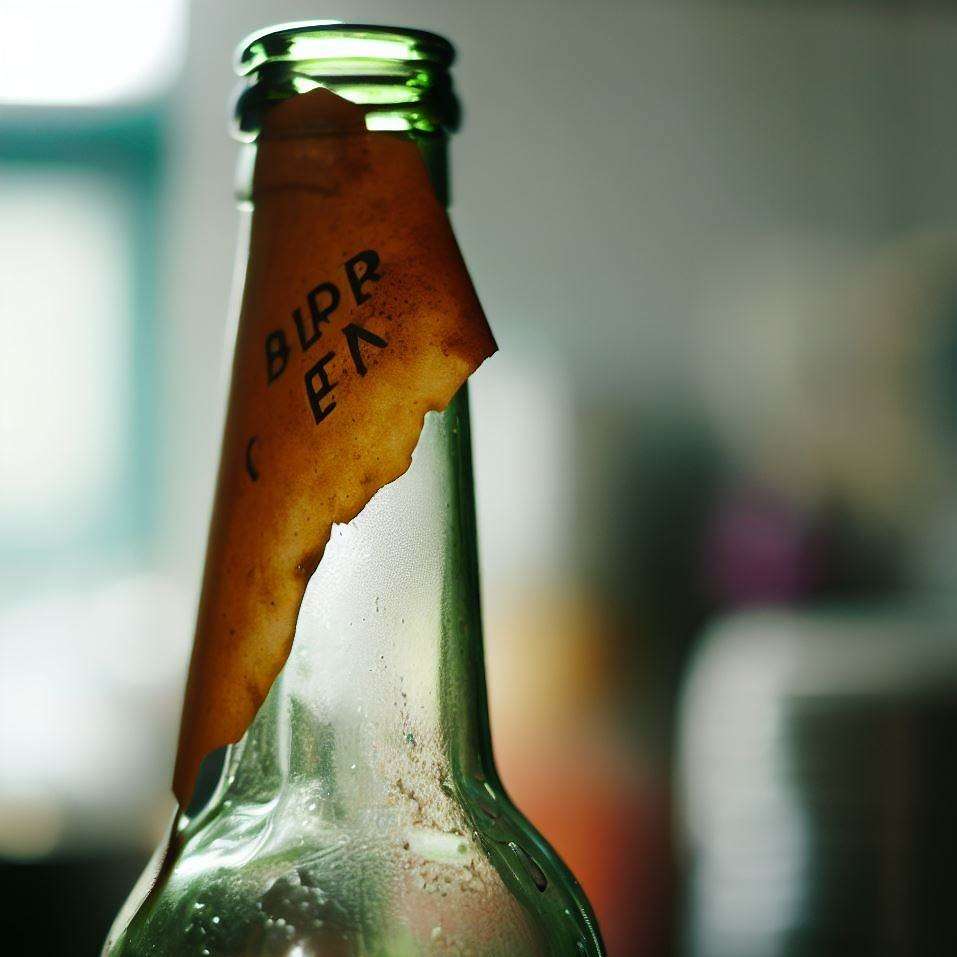Easily remove bottle labels with our quick tips. Bid farewell to stubborn adhesive for a hassle-free process, leaving bottles smooth and label-free.
Table of Contents
Soaking Method
The soaking method is a great way to remove labels without damaging the bottle or leaving behind residue.
To use this method, start by filling a sink or large bowl with warm water and a few drops of dish soap.
Make sure that the label is completely submerged in the water, and let the bottle soak for at least 30 minutes.
Once the label has had time to soak, use your fingers or a scraper to gently peel it off.
If the label doesn’t come off easily, use a scrub brush or sponge to remove any remaining adhesive residue.
For stubborn labels, you can enhance the soaking method by adding baking soda or white vinegar to the warm water solution.
Both ingredients act as natural agents to break down adhesive bonds. Add a quarter cup of baking soda or a few tablespoons of white vinegar to the warm soapy water before soaking the bottle.
Additionally, if the bottle has a paper label, try to score it with a utility knife before soaking to allow the water to penetrate and loosen the adhesive more effectively.
Ensure that the water remains warm throughout the soaking process for optimal results.
After removing the label, wipe the bottle clean with a damp cloth to eliminate any lingering soap, baking soda, or vinegar residue.
This method not only effectively removes labels but also leaves your bottles looking pristine without the need for harsh chemicals or abrasive tools.
Heat Method
The heat method is another effective way to remove labels from bottles.
Preheat your oven to 350°F and place the bottle in the oven for about 5-10 minutes. This will soften the adhesive on the label and make it easier to remove.
Once the bottle has been heated, use a pair of tweezers or a razor blade to gently lift off the label. Be sure to use caution as the bottle will be hot.
If the label still doesn’t come off easily, try using a scrub brush or sponge to remove any remaining adhesive residue.
To enhance the effectiveness of the heat method, consider applying cooking oil or WD-40 to the label before placing the bottle in the oven.
These substances can further penetrate and break down the adhesive, making it simpler to peel off the label.
Prior to heating, generously apply the oil or WD-40 to the label, ensuring even coverage.
After heating, let the bottle cool slightly before attempting to remove the label.
The combination of heat and the penetrating properties of the oil or WD-40 can facilitate a smoother label removal process.
Once the label is lifted, wipe the bottle with a clean cloth to remove any remaining oil or residue.
This method not only provides an efficient way to remove labels but also minimizes the need for excessive scraping or scrubbing, preserving the integrity of the bottle’s surface.
Chemical Method
If neither the soaking nor the heat method works, you can try using a chemical solution to remove the label.
There are many label removers and adhesive solvents available in stores that can make the process much easier.
Apply the solution to the label and wait for a few minutes, or according to the instructions on the product.
Use a scraper or cloth to remove the label and adhesive residue. Be sure to follow the product instructions carefully.
For a more DIY approach to a chemical solution, consider using acetone or nail polish remover.
Apply a small amount to the label and let it sit for a few minutes, allowing it to break down the adhesive.
Exercise caution and ensure proper ventilation when using these products.
After the allotted time, use a scraper or cloth to gently lift off the label.
If any residue remains, dampen a cloth with more solvent and carefully wipe away the sticky remnants. Take care not to use excessive force, especially on delicate surfaces.
It’s crucial to thoroughly clean the bottle after using a chemical solution to remove any remaining solvent.
Rinse the bottle with water and mild soap to ensure there are no traces of the chemical left behind.
This method is effective for persistent labels but requires careful handling and adherence to safety guidelines.
Tips for Success:
- Be patient. Removing labels can be a time-consuming process, so be prepared to spend some time on it.
- Use caution when using the heat method, as the bottle will be hot.
- If the label tears, try using a scraper or razor blade to remove the smaller pieces.
- If the adhesive residue is stubborn, try using a label remover or adhesive solvent to make the process easier.
- Be sure to wash the bottle thoroughly after removing the label to remove any remaining adhesive residue.
In conclusion, removing bottle labels can be a frustrating task, but there are several methods to make the process easier.
Whether you use the soaking method, the heat method, or a chemical solution, be sure to be patient and follow the instructions carefully.
With a little effort, you can remove bottle labels easily and effectively.
FAQs ( Remove Bottle Labels )
Q1: How can I effectively remove bottle labels without damaging the bottle?
There are several effective methods for label removal. The soaking method, heat method, and chemical solutions are commonly used. Each method has its own set of instructions to ensure safe and damage-free label removal.
Q2: What is the soaking method, and how does it work?
The soaking method involves submerging the bottle in warm, soapy water for at least 30 minutes. This process helps loosen the adhesive, making it easier to peel off the label. Baking soda or white vinegar can be added for stubborn labels, and a gentle scrub brush can aid in residue removal.
Q3: How does the heat method work, and is it safe for all bottles?
The heat method requires placing the bottle in a preheated oven to soften the adhesive. Caution is essential to avoid burns, and the method may not be suitable for all bottles, especially those made of delicate materials. Applying cooking oil or WD-40 before heating can enhance the effectiveness.
Q4: When should I consider using a chemical solution to remove labels?
If soaking and heating methods prove ineffective, a chemical solution can be used as a last resort. Commercial label removers or DIY solutions like acetone or nail polish remover can be applied to break down the adhesive. Follow product instructions carefully, and ensure proper ventilation when using chemical solutions.
Q5: Is it safe to use acetone or nail polish remover on all bottle surfaces?
Exercise caution when using acetone or nail polish remover, especially on delicate surfaces. It’s essential to follow safety guidelines and ensure proper ventilation. If in doubt, consider testing a small, inconspicuous area before applying the solution to the entire label.
Q6: How long does the label removal process typically take?
Removing labels can be a time-consuming process. The duration depends on factors such as the method used, the type of label, and the stubbornness of the adhesive. Patience is key for successful label removal.
Q7: What should I do if the label tears during removal?
If the label tears, use a scraper or razor blade to carefully remove the smaller pieces. Take your time and proceed with patience to avoid causing damage to the bottle.
Q8: Are there any tips for ensuring a clean finish after label removal?
After label removal, wipe the bottle with a clean, damp cloth to eliminate any remaining residue. Thoroughly clean the bottle with mild soap and water to ensure there are no traces of adhesive or cleaning agents left behind.
Q9: Can I reuse bottles after label removal?
Yes, bottles can be reused after label removal. Ensure thorough cleaning to eliminate any residual adhesive or cleaning agents, and the bottle will be ready for reuse.
Q10: What precautions should I take during the label removal process?
Always exercise caution, especially when using heat or chemical methods. Follow method-specific safety guidelines, and ensure proper ventilation when using chemical solutions. Additionally, be patient and take your time to achieve the best results without causing damage to the bottle.



Comments